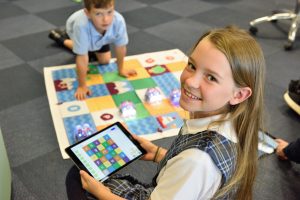While researching tablet use and fine motor skills, I found my last post’s article and today I found a response to that article from an occupational therapist’s perspective. It was helpful to read that occupational therapists have the same concerns as I do in regard to scientifically proving that apps are actually beneficial not just trusting that the app creators know what they are doing.
In “Two-dimensional Solutions in a Multi-dimensional World? A Commentary on “Effect of Touch Screen Tablet Use on Fine Motor Development of Young Children”” by Franzina Coutinho (2017), she discusses her own study (Coutinho et al., 2017) that found no differences in the conclusions between the groups using traditional methods to improve visual motor skills and the group using tablet apps (Coutinho, 2017). I appreciated that the app used was selected and supervised by the occupational therapist to meet particular goals, but we don’t know what criteria was used to select the app. The apps used where unfortunately not mentioned or put in the reference section, and thus, I can not review them myself.
However, like I have said in previous posts, she stated that “An evaluation rubric…might be a helpful tool that could help with appropriate app selection” (2017 p. 469). She also thought that “research supporting improved occupational performance when implemented appropriately by the therapist” (2017 p. 469) was necessary.
She shared an evaluation rubric created by Harry Walker which is posted on https://www.ipads4teaching.net/critical-eval-of-apps.html. (The link in the article is no longer valid and I had to do a bit of searching to find the rubric.) This rubric is not appropriate for evaluating the success of apps when supporting visual motor skills or other occupational therapies. I did a quick Google search and didn’t find much. I will be asking Alison, when she joins our class next week, if she has a tool to evaluate apps that she uses with her clients.
Similarly to teaching, Coutinho states that “we need to adapt [technologies] and tailor them to the child’s individual needs and targets” (2017 p. 469). Like I have said in previous posts, adult interaction with the child during app use “might ensure better skill development and carryover” (Coutinho, 2017) in situations outside of the tech world. Students and children don’t always make the connections on their own and need guidance from adults.
Reference:
Coutinho, F. (2017). Two-dimensional solutions in a multi-dimensional world? A commentary on “effect of touch screen tablet use on fine motor development of young children”. Physical & Occupational Therapy in Pediatrics, 37(5), 468-470.


Leave a Reply
You must be logged in to post a comment.